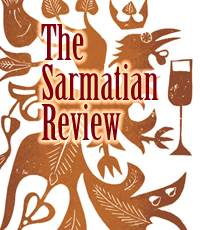| This Issue | Back Issues | Editorial Board | Contact Information |

BOOKS and Periodicals Received
September 2005
Volume XXV, No. 3
Belaruskija narodnyja kryzhi [Belarusan national crosses], by Michas' Ramanjuk. Vilnius: Nasha Niva, 2000. Illustrations, Index. 221 pages. Hardcover. Price: 116 litas. In Belarusan.
Michas' Ramanjuk (1944-1997) was a prolific ethnologist and a gifted photographer who spent thirty years traveling in Belarus in the course of ethnographical research and photographic studies. His extraordinary survey of Belarusan folk crosses and burial customs is both a coffee table album and a scholarly monograph. The 303 black-and-white photographs, many of which reveal a world still untouched by modern technology, capitalism, and consumerism, offer a glimpse of the communal character of the Slavic and Baltic folk cultures. The text here is in Belarusan, with a separate English-language table of contents, author's biography, index and description of each photograph, and summary. Some of the photographs call to mind the work of renowned Polish photographer Adam Bujak, although Ramanjuk's powerful, ghostly black-and-white photographs, especially those depicting humans in cemeteries, have more of a haunting, timeless quality than Bujak's recent commercialized work.
Ramanjuk portrays a variety of crosses: graveyard, roadside, wooden, stone, and metal, most of which have been popularly believed to possess an almost supernatural power protecting the common folk from misfortune and evil spirits. Crosses erected at crossroads were intended to be places of rest and nourishment for the spirits that wandered the roads. In addition to crosses, Ramanjuk provides photographs and descriptions of other markers, decorations, and inscriptions encountered in cemeteries. Specific and simple pole-like markers designate the graves of unbaptized children and suicides. Certain graves are topped by a wooden sarcophagus-like grave construction (narub), while others are covered with a grave log (pryklad) of human-like proportions. A mixture of Christian and pre-Christian customs is observed throughout.
A specific feature of Belarusan crosses, especially in the Polesie region, is decoration with a traditional embroidered towel (ruchnik) similar to the ceremonial cloths often displayed atop Ukrainian and Romanian religious icons. Unlike the latter, however, which merely drape icons, the Belarusan cloths are wrapped about the crosses according to specific symbolic patterns. As Ramanjuk, also a specialist in Belarusan folk dress, demonstrates in comparative illustrations, there are parallels between the decoration of a cross and the traditional dressing of the groom during the wedding ceremony, when the groom's attendants wrap him with a long, decorative ceremonial cloth. Scholars have suggested that the ceremonial embroidered towels, commonly exhibited upon icons in the "holy corner" of the Ukrainian and Belarusan peasant dwelling, are a pre-Christian relic of the culture of the ancient Indo-Iranian Sarmatians.
This volume will appeal to anyone interested in the work of Adam Mickiewicz, the Polish Kresy, Slavic burial traditions, or pre-Christian Slavic culture. Of special interest for Polish readers are the photographs and descriptions of the autumnal feast of Dzjady (Polish: Dziady). The photographs from cemeteries, dating chiefly from 1989 celebrations of the Dzjady feast, depict women in traditional folk costume and food and drink offered to the spirits of the deceased. Quite expensive by the standards of current publications from Lithuania and Belarus, the volume was purchased in 2004 in Vilnius; it is a priceless investment for any library, public or private, that deals with Slavs. Such remarkable, haunting photographs as these are not often seen today. (Kevin Hannan)
Las w lustrach/Forest in the Mirrors, by Janusz Szuber. Translated by Ewa Hryniewicz-Yarbrough and Clare Cavanagh. Rzeszów: YES (wydawnictwo@yes.pl), 2001. 72 pages. Illustrations. ISBN 83-911519-2-1. Bilingual Polish/English. A beautifully published book of poetry accompanied by illustrations reminiscent of Tolkien's world. Szuber's poetry deals with nature and human nature; it is born of mature reflection and it looks back toward Czesław Miłosz.
The Polish Underground Army, the Western Allies, and the Failure of Strategic Unity in World War II, by Michael Alfred Peszke. Foreword by Piotr S. Wandycz. Jefferson, NC: McFarland, 2004. x + 244 pages. Index, bibliography, appendices. ISBN 0-7864-2009-X. Hardcover.
Moja Polska: Eseje o polskości/My Poland: Essays on Polish Identity, by Kevin Hannan. Translation into Polish by Jacek Serwalski. Poznań: Wydawnictwo Poznańskie, 2005. 283 pages. ISBN: 83-7177-204-1. Paperback. Bilingual Polish/English. Essays on Polish history, culture, language, and religion.
Back to the September 2005 Issue
The Sarmatian Review
sarmatia@rice.edu
Last updated 7/25/05